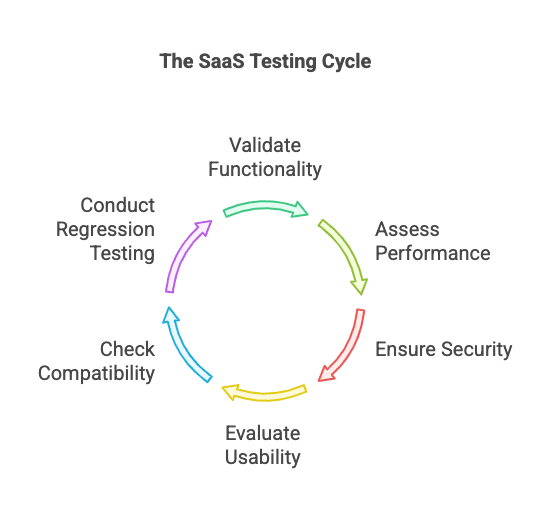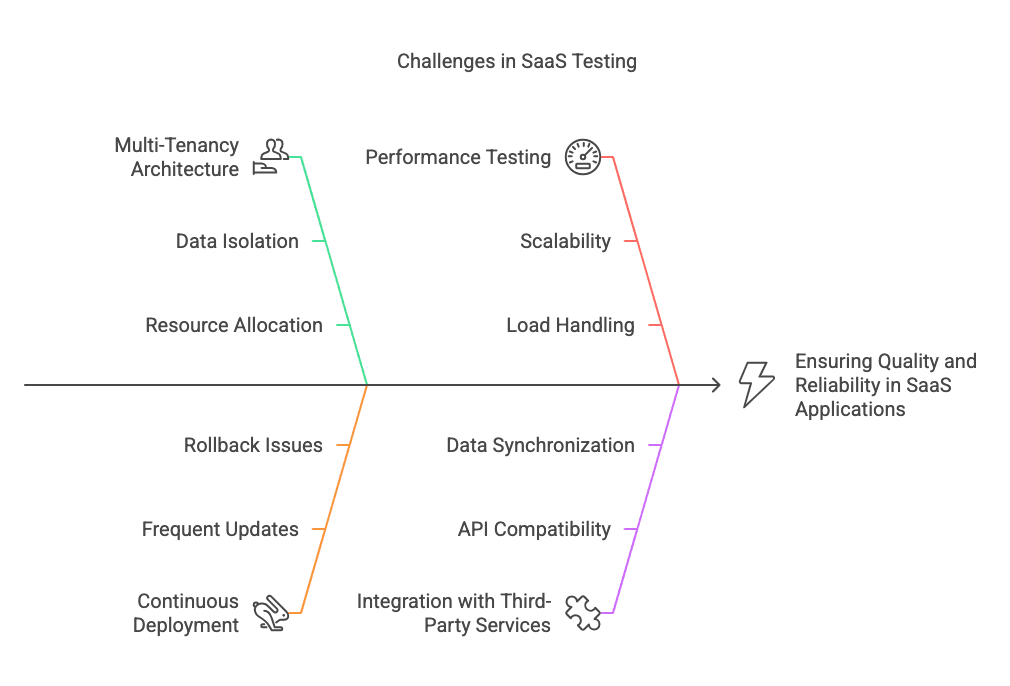SaaS, or Software as a Service, has become a pivotal part of modern software development practices. As businesses continue to rely more on web-based applications, ensuring these applications deliver optimal performance and meet user expectations has become paramount.
That's where SaaS testing comes into the picture. It helps organizations maintain application reliability, enhance user experience, protect user privacy, and comply with regulatory requirements.
In addition, it verifies that the SaaS application functions consistently across various web browsers, operating systems, and devices. However, it does come with its unique set of challenges, strategies, and importance that we’ll delve into in this blog post.
What is SaaS Testing and How Does it Work?
SaaS testing involves validating that a SaaS (Software as a Service) product meets defined requirements and will perform as expected in a real-world scenario.
It comprises conducting checks for security, functionality, performance, usability, accessibility, integration, maintenance and user acceptance. By executing comprehensive SaaS application testing, organizations can ensure their web-based applications are secure, reliable, and provide a seamless experience for end users.
Also read: 12 Must-See SaaS Demo Examples To Watch Out
Why Should You Test Your SaaS Application?
Testing your SaaS application is crucial to validate its performance and ensure reliability under different conditions. Next, it safeguards user privacy and ensures data security.
It helps organizations comply with industry regulations, thereby reducing legal risks. Lastly, it helps enhance the user experience with bug fixes in a proper test environment Below, we will discuss these reasons with more detail.
Ensure application reliability and performance
Quality assurance is of paramount importance in a competitive market, making it an essential element in the world of SaaS. One of the foremost testing activities in SaaS testing is checking the application's reliability and performance.
This usually involves functional testing, where testers ensure that all software functionalities work as expected from an end-user perspective. In addition, performance testing becomes crucial in verifying that your SaaS application can handle increased load and traffic while maintaining seamless performance.
Protect user privacy and data security
Securing user data and ensuring privacy has become a priority in the online world, and this goes hand in hand with SaaS applications.. A major component of SaaS testing involves conducting rigorous security tests to protect user data and privacy.
Security testing, in the case of SaaS is about evaluating the application’s resilience against potential threats and vulnerabilities. This could be a matter of running penetration tests to identify the weak points in the system that could be exploited, or it could involve setting up security protocols like encryption and secure access controls to safeguard user data.
Meet regulatory and compliance requirements
Every SaaS application that deals with personally identifiable information (PII), financial details, health records, or any sensitive data must adhere to certain regulatory and compliance standards. These mandates are put in place to safeguard user data and maintain industry standards.
For instance, a SaaS application handling credit card transactions needs to comply with the Payment Card Industry Data Security Standard (PCI DSS). Similarly, applications managing health-related data may need to comply with the Health Insurance Portability and Accountability Act (HIPAA) regulations.
Enhance user experience with bug-free features
In the highly competitive SaaS market, user experience plays a pivotal role in retaining users and building a strong customer base.
A critical part of enhancing user experience is ensuring that all key features of a SaaS application work as intended without any glitches or bugs. Hence, an important part of your SaaS testing process should be aiming for bug-free features.
The first step in achieving this is through functional testing. During functional testing, each feature and functionality of the application are checked individually to validate if they work as intended. This helps to identify any bugs or defects that could hamper the user experience.
What are the 6 Elements of SaaS Testing?

Six primary elements form the core of SaaS testing. They include security testing, performance testing, scalability testing, functional testing, test automation, and API testing.
Each of these elements plays a vital role in ensuring the SaaS application's reliability, performance, security, and overall user experience. Using a systematic approach and applying best practices for each of these tests ensures a more complete and effective SaaS application testing strategy.
Security testing
A major element of SaaS testing is security testing. It is a process that uncovers vulnerabilities or weaknesses that could allow unauthorized access, data leaks, or other security breaches.
Security testing includes:
- Penetration Testing - It involves simulating attacks from a malicious source to uncover vulnerabilities.
- Authentication - This testing verifies that only authorized users can gain access to the application.
- Data Encryption - Checks are performed to confirm that sensitive data is appropriately encrypted while in transit or at rest.
- Compliance Testing - It is done to ensure that the SaaS application is in compliance with relevant security standards and regulations.
Conducting thorough security testing not only prevents data breaches but also greatly enhances user trust in the software.
Performance testing
Performance is a key determinant of the success of any software application, and SaaS applications are no exception. Users expect swift response times, seamless interactions, and optimal performance even under high load conditions.
Performance testing is the process that evaluates how an application behaves when subjected to different types of loads and stresses. It includes load testing, stress testing, spike testing, and volume testing.
Scalability
Scalability is an important feature of SaaS applications. As user needs and volumes grow, the ability of the application to scale accordingly can significantly impact its performance.
Scalability testing is a branch of performance testing that evaluates an application's ability to handle load increases without adversely impacting performance or user satisfaction. It involves accurately measuring system performance before and after scaling operations (including increased processing power, higher storage capacity, etc.)
Functional testing
Functional testing is a critical aspect of SaaS testing. It verifies that each component of a SaaS application functions as intended. This involves testing features, workflows, user interface elements, integrations, and more. The aim is to uncover any defects that may prevent the software from fulfilling its intended purpose.
During functional testing, you check the software against specific functional requirements and specifications. The functions of the software are tested by providing inputs and examining outputs, ensuring that the software behaves as expected.
By performing thorough and regular functional tests, organizations can ensure their SaaS applications are free from bugs, leading to improved user satisfaction and increased adoption.
Test automation
Test automation refers to the use of software to control the execution of tests, compare actual outcomes with predicted outcomes, set up test preconditions, and manage other test control and test reporting functions. It’s employed when testing repetitive tasks, regression tests, load tests, and sometimes for functionality testing as well.
The benefits of test automation include increased speed and efficiency in the testing process, repeatability, reusability, and improved accuracy since it eliminates the risk of human error. These make it an ideal approach for SaaS applications that have frequent releases and updates.
API testing
API testing is another critical aspect of SaaS testing, and it revolves around testing application programming interfaces (APIs), the conduits through which different software components communicate with each other.
In the context of SaaS, you're often dealing with web-based APIs. This means they use standard web protocols such as HTTP or HTTPS, and formats such as XML or JSON, to share data and functionality.
During API testing, the following areas are typically evaluated:
- Functionality: Does the API perform its intended tasks correctly?
- Reliability: Can the API consistently perform its intended tasks without failing?
- Load: Can the API handle a large number of requests without slowing down or crashing?
- Security: Is data shared via the API protected from unauthorized access?
By conducting rigorous API testing as part of their SaaS testing process, organizations can ensure that their software's API layer is robust, secure, and reliable.
Also read: Top 8 interactive demo tools for 2024.
Top 6 Tips To Develop Effective SaaS Testing Strategy

Creating an effective SaaS testing strategy is vital to uncovering potential issues in the early stages of development and reducing future maintenance costs.
Check Browser compatibility to ensure functionality across all browsers
To ensure seamless functionality across different browsers, SaaS testing involves checking browser compatibility extensively. This step verifies that the SaaS application performs optimally on various browsers, catering to a wide user base.
By conducting compatibility testing, QA teams confirm that users can access the SaaS application seamlessly regardless of the browser they use. This process enhances user satisfaction and ensures a consistent user experience across different platforms and devices. Compatibility testing is crucial in the SaaS testing methodology to deliver a high-quality SaaS product.
Automated testing to speed up the process
Automated testing is another valuable strategy to consider when developing a SaaS testing approach. It's particularly useful when you have repeatable tasks, frequent regression testing, load testing, or scripts that need to be executed repeatedly, that can take up substantial time during manual testing.
Here’s how automated testing can speed up the process:
- Efficiency - Automated tests are quicker to run than manual tests, significantly reducing the time taken for repetitive tests.
- Accuracy - Automated tests eliminate human errors, delivering highly accurate results.
- Reusability - Test scripts are reusable and can be used across different versions of the software, saving considerable time in test case preparation.
- Faster Feedback - Automated tests provide faster feedback during the development process, helping to resolve issues more quickly and effectively.
By incorporating automated testing into your SaaS testing strategy, you'll not only accelerate the process but also improve the overall quality and accuracy of outcomes, enhancing the final product's reliability.
Cross-platform testing solutions to test functionality across different devices
In today's digital landscape, users access SaaS applications from different devices with different screen sizes, such as laptops, tablets, and smartphones. This makes it crucial to ensure your application functions seamlessly across all devices and platforms. Therefore, integrating cross-platform testing solutions in your SaaS testing strategy is a smart move.
Cross-platform testing involves validating aspects like functionality, UI design, consistency, and performance of a SaaS application over multiple platforms and various platforms. This includes different operating systems, browsers, screen resolutions, and hardware configurations.
Security & compliance testing to ensure data security and privacy standards
SaaS security and compliance testing are crucial for maintaining high standards of data security and privacy. By implementing thorough testing procedures, companies can safeguard sensitive information and ensure compliance with regulations.
It involves assessing vulnerabilities, encryption mechanisms, and access controls to prevent data breaches and unauthorized access. Compliance testing verifies adherence to industry standards and legal requirements, guaranteeing the trust and confidence of users in the SaaS application. Prioritizing security and compliance in testing is fundamental to preserving the integrity and confidentiality of data.
Continuous integration and continuous testing to improve software quality
Implementing continuous integration (CI) and continuous testing (CT) is essential for maintaining high software quality in SaaS applications. CI involves automatically integrating code changes from multiple developers into a shared repository, ensuring that the software remains cohesive and functional. CT complements this by automating the testing process to detect bugs early and often throughout the development cycle.
This approach reduces the risk of major defects, speeds up the delivery process, and fosters a culture of accountability. Automated testing tools can run a suite of tests every time new code is integrated, covering unit tests, functional tests, and regression checks. By identifying and resolving issues immediately, CI and CT create a seamless pipeline that improves code quality, enhances team efficiency, and ensures a robust, user-friendly SaaS product.
Develop performance testing capabilities to ensure expected output
The performance of a SaaS application directly impacts user experience. If an application does not deliver on its promised speed and responsiveness, users are likely to abandon it. Hence, developing your performance testing capabilities is a focal point of an effective SaaS testing strategy.
Performance testing involves assessing how well the application performs under different conditions, such as varying user loads, network speeds, or different amounts of data. This ensures that even during peak usage, the application maintains robust performance without faltering in speed or functionality.
6 Common Challenges in SaaS Testing

In the development of SaaS applications, a key step in ensuring quality delivery is performing thorough SaaS testing. However, this process comes with its own set of unique challenges. Understanding these SaaS testing challenges will help enhance your SaaS app and improve your application performance.
Frequent Releases & Limited Time for Testing
In the rapidly developing SaaS industry, products and applications undergo frequent updates and releases, including new features. This can place a significant strain on QA teams as they have to constantly conduct new tests and regression testing to ensure software quality after these updates. Hence, managing frequent releases within the constraints of limited testing time becomes a significant challenge in SaaS testing.
Key challenges when dealing with frequent releases:
- Limited Time: Rapid release cycles often leave limited time for comprehensive testing.
- Increased Complexity: Frequent updates increase the complexity of the application, rendering it more challenging to test.
- Regression Testing: Regular updates necessitate recurrent regression testing to ensure updated features don't impact existing functionalities adversely.
- Resource Allocation: Deciding when and where to divert key resources becomes challenging in the face of regular releases.
To address these challenges, it's crucial to consciously incorporate strategies such as prioritization of testing tasks and automation of repetitive tests.
Testing applications with real data
Another significant challenge in SaaS testing is testing applications with real or production data. The real data is usually confidential and sensitive, making it one of the major challenges for testers to use it for testing purposes due to privacy and data protection regulations.
Moreover, because real users constantly use SaaS applications, the data keeps changing at unprecedented rates. This dynamic nature of data can make it difficult for testers to capture scenarios for regression tests.
Privacy and Security Issues
Data privacy and security are paramount considerations when performing SaaS application testing. Given the shared and often multi-tenant nature of SaaS applications, ensuring data privacy poses a significant challenge.
Different users might be operating on the same systems; thus, strategies must be enacted to prevent unauthorized access to sensitive information.
On the other hand, given the online nature of these applications, they are often susceptible targets for various cyber threats. Ensuring the fortress-like security of user data becomes a mammoth task for SaaS testers.
Integration and API Testing
Given the highly modular nature of modern SaaS applications, they often incorporate several integrations with other services and tools. Therefore, ensuring smooth and seamless interactions becomes crucial to the overall performance of the application, particularly in the context of the SaaS model, and it poses a significant challenge in SaaS testing.
Remember, the goal of integration testing is to ascertain that the interactions between two disparate systems or modules function as expected. It includes checking data flow, functional interactions, and communication protocols.
Licensing & Functional Testing
Understanding and complying with licensing requirements forms another challenge in SaaS testing. Different components or integrations of a SaaS application may have distinct licensing requirements, and violations can lead to fines or even legal action.
However, testing for licensing compliance can be complex due to the heterogeneity of software licenses. Therefore, maintaining a thorough and up-to-date understanding of all licensing agreements associated with a SaaS application becomes critical for SaaS testers.
Tester vs. Developer ratio
Maintaining the right balance between developers and testers in a team can be a challenge in SaaS testing. While developers focus on creating the software functions and features, testers are tasked with ensuring the application is operating correctly, looking for any bugs, errors, or performance issues.
If an organization fails to properly allocate its resources between developers and testers, it can lead to shortcomings in the testing process, compromising the quality of the final product. This becomes more crucial in scenarios where SaaS products follow an aggressive release schedule, prompting a constant need for thorough and time-efficient testing.
How Can SmartCue Help Test a Product?
Testing is a critical step in the product development process, ensuring that your SaaS solution meets user expectations and performs seamlessly. SmartCue’s interactive demo platform offers innovative tools to simplify and optimize product testing. Here's how;
Real-World User Scenario Simulations
SmartCue allows you to replicate real-world user interactions, helping you test your product under practical conditions. These simulations uncover potential issues and ensure your product is equipped to handle everyday challenges, providing a more authentic evaluation of its performance.
Functional Testing with Interactive Walkthroughs
With SmartCue’s interactive walkthroughs, you can conduct thorough functional testing of your product’s features. Thorough functional testing involves systematically verifying each feature of your product to ensure it works as intended. This includes checking inputs, outputs, and user interactions to identify and fix any issues before launch. This process validates that each functionality operates as intended, ensuring your product meets the high standards required for a successful launch.
Usability Testing Through User Interaction
SmartCue enables teams to gather critical usability insights by letting users interact with the product in a demo environment. This hands-on approach identifies areas where the user experience can be improved, ensuring your product is intuitive and easy to navigate.
SmartCue transforms product testing into a streamlined and insightful process, helping you build a product that resonates with your audience and performs flawlessly.
Conclusion
SaaS testing is imperative in determining the success of a Software as a Service product. By carefully conducting comprehensive SaaS product testing in critical areas such as performance, security, functionality, and scalability, you can guarantee that your SaaS product delivers a persistent and satisfactory user experience across all devices and browsers.
Frequently Asked Questions
What are the key types of testing involved in SaaS?
The key types of testing involved in SaaS include functionality, integration, performance, usability testing, accessibility, security, and automation testing. Every type of testing plays a crucial role in verifying important aspects of the SaaS application.
How do you handle security and privacy concerns during SaaS testing?
Security and privacy concerns during SaaS testing are handled through strict compliance testing, application of data encryption standards, secure protocols, penetration tests, and the implementation of strong access control mechanisms. In addition, synthetic data and data masking techniques can be used to ensure data privacy during testing.
What tools do you use for SaaS testing?
Various automation tools can be employed for effective SaaS or software testing. Some common SaaS testing tools include Selenium for functional testing, JMeter for performance testing, Testsigma as a testing tool for codeless automation, Postman for API testing, and OWASP ZAP for security testing, among others.
What role does user feedback play in SaaS testing?
User feedback plays a crucial role in SaaS testing as it provides insight into real-world user experiences, helping identify areas of improvement or potential issues. It is especially valuable during usability and acceptance testing stages, where user satisfaction is primary.


